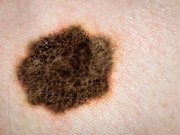Tag: Cancer: Skin
Few Indoor Tanners Have Been Screened for Skin Cancer
Correlates of screening include older age, family history of melanoma or skin cancer, high SPF sunscreen use
Hydrochlorothiazide Tied to Non-Melanoma Skin Cancer Risk
Dose-response association seen for basal cell and especially squamous cell carcinoma
S. epidermidis Producing 6-HAP May Protect From Skin Neoplasia
6-HAP selectively inhibited proliferation of tumor lines in culture; cut incidence of UV-induced tumors in mice
Dermoscopic Criteria Identified for Diagnosing Melanoma in Situ
Most frequent dermoscopic criteria for MIS are regression, atypical network, irregular dots/globules
Obesity Linked to Improved Survival in Metastatic Melanoma
Survival benefit limited to male patients receiving targeted therapy, immunotherapy
2005 to 2014 Saw Increase in Melanoma Incidence
For males and females combined, incidence fell for those aged 15 to 44, increased for those ≥55
Eyelid Squamous Cell Carcinoma Rate Increasing in England
Older age and male sex, but not social deprivation, are associated with higher eyelid SCC risk
Guidelines of Care Developed for Skin Cancer Management
Recommendations for basal cell carcinoma, cutaneous squamous cell carcinoma released
High Response of Desmoplastic Melanomas to PD-1 Blockade
Higher percentage of PD-L1-positive cells in the tumor parenchyma of desmoplastic melanomas
Fluorouracil Tied to Reduced Surgery for Squamous Cell CA
Reduced risk of squamous cell carcinoma, but not basal cell carcinoma, for one year in at-risk veterans














